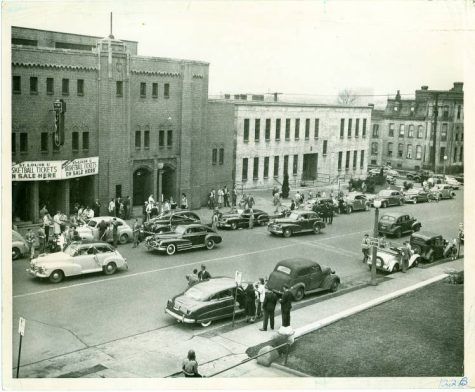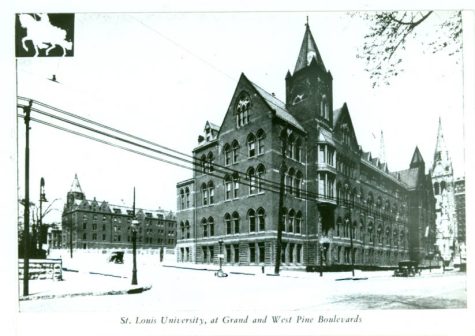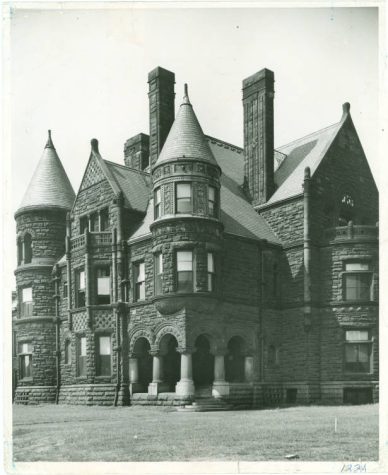Tales From the Archives
The Obscured Histories of SLU’s Most Recognizable Buildings
Pius XII Library at Saint Louis University boasts an impressive archive. They have preserved over a hundred years of SLU history through the collection of yearbooks, posters and, above all, thousands of photos. What’s more, is that you can access so much of this online through the library’s digital collections.
Without a doubt, the most intriguing part of the archives is the photos, especially of SLU’s campus life. With simply a glance, the photos pull the viewer into the strange yet familiar past. It’s easy to fall into the habit of looking at the buildings on campus and seeing nothing past their dull facades, but to do this can gloss over so much. The buildings each have their own history that can excite and inspire or that at least are weird enough to become a fun fact.

The Center for Global Citizenship (CGC) has been a feature of SLU’s campus for nearly 100 years, though its purpose is a relatively new change. Built in 1925 as The West Pine Gym, it was home to SLU’s Men’s Basketball team and served as a sports venue until 2008. In 2014, it reopened as the CGC known today. In this picture, it also serves as a bedrock of sorts, a helpful touchstone to see the change around it.
Seeing West Pine as a true street can be a bit jarring, however, it would serve that purpose until 1970, when it was converted into a pedestrian thoroughfare.
Also, present in these pictures is Des Peres Hall, though with a much drearier look than today. Built in 1947, shortly after World War II, Des Peres was created out of a dire necessity for more classroom space. However, since building materials were scarce following the War the price was reputed to be extreme. The high price did not mean an impressive style, and a cost cutting measure led to the building’s austere look. The construction of the building itself was strange as well; despite the clear need for classroom space, the building was only worked on at night in double shifts. Rumors began to circulate that it was built by an East Saint Louis gang, called “Egans Rats” for an egregious amount of time and dubbed “Egans Haul.”

DuBourg Hall stands out for its unique architectural style, not shared by many other surrounding buildings. It fits right at home next to College Church, as they are both built in a Gothic style, but when viewed within the campus as a whole, the building can seem like an ancient anomaly. In many ways, this ancient feeling may have been intentional. At the time of Dubourg Hall’s construction, the university was in a time of great transition. The university was moving from its downtown campus to the new midtown location. By channeling this older style they were giving the university a more grounded feeling while getting acquainted with their new home. This feeling was important because at the time the entire university was in DuBourg. The building had dormitories for both Jesuit priests and students, classrooms, offices, a library and laboratories. Dubourg can be seen as serving as an architectural cornerstone for the university. The building channels an ancient style in order to ground the school in its Jesuit and Catholic roots. However, its contrast with surrounding buildings also demonstrates that the university isn’t stuck in its ways and has found its own path forward.

If DuBourg Hall stands out for its unique architectural style, the Cupples House goes even further. Not only is it in the unique and grand Romanesque revival style, but it also stands alone as a house in the middle of a college campus. The building’s history seems to match its peculiar circumstances. Built in the 1880s by millionaire entrepreneur Samuel Cupples, it was built on the highest ground in Saint Louis at the time. Around the same time that Cupples was beginning his construction, the Jesuits were beginning the move to their new Midtown campus as well. Cupples would not appreciate his new neighbors, and his relationship with them would be strained from the start. Part of this can be attributed to SLUs new location blocking his view, as well as Cupples’s preference for SLU’s rival college, Washington University. Cupples took this grudge to the grave, stipulating in his will that the house should not be sold to SLU. Cupples would not get his way in the end, the home was sold to and used by a telegraph union and would later come to SLU in 1946.
It can be easy to look past all these buildings and see them as nothing more than antiquated relics. However, there is much more to be said about these buildings beyond their architectural styles. Each building has a history and a legacy that is fascinating. It’s impossible to say all the buildings on campus will have an interesting story, some really are as unassuming as they seem, but it is still important to look, pause for a moment and realize the buildings we pass every day are part of a larger context that is often hard to appreciate but is immensely impressive.
Your donation will support the student journalists of Saint Louis University.



